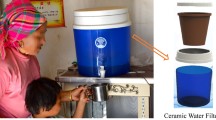Abstract
Water is necessary for the survival of all living beings, essential for health and should be a fundamental right for every human being. Thus, to provide enough water with good quality to populations, researchers are currently focusing on the development of innovative processes, such as ceramic water filters, that are easy to operate and inexpensive. The objective is to allow access to sufficient quality water at the point of use. To this end, one of the innovative techniques that has been applied in various fields of science is three-dimensional (3D) printing. In the present work, a 3D printer, Ultimaker 1, initially intended for plastic-based printing, was adapted for use in the manufacture of ceramic filters. These filters can find applications in water treatment for consumption at the point of use. Our study shows that this innovative concept could become a viable alternative in the near future for supplying a sufficient quantity of good-quality drinking water in developing countries.







Similar content being viewed by others
References
Bain R, Cronk R, Hossain R et al (2014) Global assessment of exposure to faecal contamination through drinking water based on a systematic review. Trop Med Int Heal 19:917–927. https://doi.org/10.1111/tmi.12334
Wolf J, Prüss-Ustün A, Cumming O et al (2014) Systematic review: assessing the impact of drinking water and sanitation on diarrhoeal disease in low- and middle-income settings: systematic review and meta-regression. Trop Med Int Heal 19:928–942. https://doi.org/10.1111/tmi.12331
Sorenson SB, Morssink C, Campos PA (2011) Safe access to safe water in low income countries: water fetching in current times. Soc Sci Med 72:1522–1526. https://doi.org/10.1016/j.socscimed.2011.03.010
van der Laan H, van Halem D, Smeets PWMH et al (2014) Bacteria and virus removal effectiveness of ceramic pot filters with different silver applications in a long term experiment. Water Res 51:47–54. https://doi.org/10.1016/j.watres.2013.11.010
Pérez-Vidal A, Diaz-Gomez J, Castellanos-Rozo J, Usaquen-Perilla OL (2016) Long-term evaluation of the performance of four point-of-use water filters. Water Res 98:176–182. https://doi.org/10.1016/j.watres.2016.04.016
Kallman EN, Oyanedel-Craver VA, Smith JA (2011) Ceramic filters impregnated with silver nanoparticles for point-of-use water treatment in rural Guatemala. J Environ Eng 137:407–415
Oyanedel-Craver V, Narkiewicz S, Genovesi R et al (2014) Effect of local materials on the silver sorption and strength of ceramic water filters. J Environ Chem Eng 2:841–848. https://doi.org/10.1016/j.jece.2014.02.002
Muzerengi C, Mhlongo SE, Mukwevho GF (2013) Characterization of clays for making ceramic pots and water filters at Mukondeni village, Limpopo province, South Africa. J Eng Appl Sci 8:927–932
TCMWG (2011) Best practice recommendations for local manufacturing of ceramic pot filters for household water treatment. Première E, Atlanta
Johnson RC, Boni G, Degbey C et al (2015) Assessment of the potential contribution of the ceramic filter “Songhai” in the treatment of drinking water in Benin (West Africa). J Water Resour Prot 7:702–706
Ho CMB, Ng SH, Li KHH, Yoon Y-J (2015) 3D printed microfluidics for biological applications. Lab Chip. https://doi.org/10.1039/C5LC00685F
Chan HN, Tan MJA, Wu H (2017) Point-of-care testing: applications of 3D printing. Lab Chip 17:2713–2739
He Z, Singh TSSG (2018) Inkjet 3D printing of clay ceramics for water treatment. Prog Addit Manuf. https://doi.org/10.1007/s40964-018-0055-1
Withell A, Diegel O, Grupp I, Reay S (2012) Porous ceramic filters through 3D printing. In: Innovative developments in virtual and physical prototyping, pp 313–318. https://doi.org/10.1201/b11341-50
Hwa LC, Rajoo S, Noor AM et al (2017) Recent advances in 3D printing of porous ceramics: a review. Curr Opin Solid State Mater Sci. https://doi.org/10.1016/j.cossms.2017.08.002
Akowanou AVO, Aina MP, Mahunon SER, Yao BK (2017) Characterization of clays from the “Sè” region in the South of Benin used to make ceramic water filters. Am J Appl Chem 5:90. https://doi.org/10.11648/j.ajac.20170506.11
Şan O, Özgür C (2007) Fabrication of glassy ceramic membrane filters for filtration of spring water with clogging phenomena. J Membr Sci 305:169–175. https://doi.org/10.1016/j.memsci.2007.08.001
Lin CF, Yu-Chen Lin A, Sri Chandana P, Tsai CY (2009) Effects of mass retention of dissolved organic matter and membrane pore size on membrane fouling and flux decline. Water Res 43:389–394. https://doi.org/10.1016/j.watres.2008.10.042
Peiris RH, Hallé C, Budman H et al (2010) Identifying fouling events in a membrane-based drinking water treatment process using principal component analysis of fluorescence excitation-emission matrices. Water Res 44:185–194. https://doi.org/10.1016/j.watres.2009.09.036
Hofs B, Ogier J, Vries D et al (2011) Comparison of ceramic and polymeric membrane permeability and fouling using surface water. Sep Purif Technol 79:365–374. https://doi.org/10.1016/j.seppur.2011.03.025
Brown J, Sobsey MD (2010) Microbiological effectiveness of locally produced ceramic filters for drinking water treatment in Cambodia. J Water Health 8:1–10. https://doi.org/10.2166/wh.2009.007
Brown J, Chai R, Wang A, Sobsey MD (2012) Microbiological effectiveness of mineral pot filters in Cambodia. Environ Sci Technol 46:12055–12061
Lantagne D, Clasen T (2013) Effective use of household water treatment and safe storage in response to the 2010 Haiti earthquake. Am J Trop Med Hyg 89:426–433. https://doi.org/10.4269/ajtmh.13-0179
Author information
Authors and Affiliations
Corresponding author
Ethics declarations
Conflict of interest
On behalf of all authors, the corresponding author states that there are no conflicts of interest.
Additional information
Publisher's Note
Springer Nature remains neutral with regard to jurisdictional claims in published maps and institutional affiliations.
Rights and permissions
About this article
Cite this article
Akowanou, A.V.O., Deguenon, H.E.J., Groendijk, L. et al. 3D-printed clay-based ceramic water filters for point-of-use water treatment applications. Prog Addit Manuf 4, 315–321 (2019). https://doi.org/10.1007/s40964-019-00091-9
Received:
Accepted:
Published:
Issue Date:
DOI: https://doi.org/10.1007/s40964-019-00091-9




